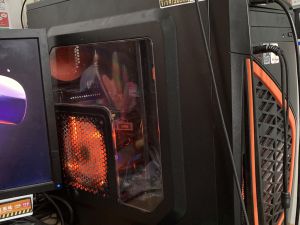DIYPC Zondda-O
More actions
The DIYPC Zondda-O is the case that I built my first custom computer in. It's a pretty cheap case, but it got the job done.
Collection Specifics
Graphics
I built this computer in March 2020, right before computer hardware prices skyrocketed, especially graphics cards. Thanks to that, I kind of regretted not jumping up a tier to a RTX 2060, so I have a GTX 1650 in my system since it's cheaper. It's still a decent card, so I'm not that upset.
On November 27, 2023, I upgraded my GTX 1650 to a PowerColor Fighter Radeon RX 6600 for around $180. This is a great deal considering the performance should be comparable to a RTX 3060, but for way cheaper.
CPU
I went with an AMD Ryzen 5 1600AF when I built this computer because it was only $85 on Amazon and it's a pretty decent CPU. Especially for only $85.
On August 2, 2024, I bought an AMD Ryzen 5 5600 for ~CA$180 from Canada Computers in Toronto as I've been wanting a little CPU upgrade for a bit. This is the latest generation Ryzen CPU my computer supports without upgrading the motherboard and it should hopefully allow this system to be performant for a little while longer than with the 1600AF. (Also I finally rotated my CPU cooler so that it doesn't block my RAM slots).
Memory
When I first built this computer, I only had 8 GB of memory installed. However, I'm an avid Cities: Skylines player and I use a lot of mods, so more RAM was helpful on that front. Now, you might be wondering how I ended up with 20 GB. Well, originally I had 2 4 GB sticks. One of these sticks is stuck under the stock AMD CPU cooler, and thanks to my laziness, I decided to buy a single 16 GB stick and just replace the easily accessible 4 GB stick.
On August 2, 2024, when I bought my Ryzen 5 5600, I also bought a pack of Corsair Vengeance 32 GB (2x16) RAM from Canada Computers. I finally fixed the wonky 20 GB setup I had and have a matching set now. I also took this chance to actually apply a XMP profile to my RAM finally, so it'll now run at full speed.
Storage
Lots of upgrades have been done to my storage configuration over time. Originally, I only had a 128 GB TeamGroup M.2 SSD and the 2 TB Seagate HDD. However, I play a lot of different games and store a lot of different things related to virtual machines, such as installation images for various operating systems, which take up a lot of space, especially newer ones. Eventually I upgraded my boot M.2 SSD to the 250 GB ADATA one since 128 GB was a bit small, then eventually I shoved in a 120 GB HP SSD that I used to use for dual booting. Lastly, I obtained a 1 TB Crucial SSD as a gift to make up my current storage configuration.
Operating System
Since this computer was built in 2020, I of course, originally installed Windows 10 Pro. Since then, I got more involved in the Windows Insider Program and started running preview builds on this machine, so now it runs Windows 11 Insider Preview builds.
I also used to dual boot Windows 7 on this machine since all of the hardware supported it, but I almost never used it. For a short time, I also had an Ubuntu dual boot and a Windows 8 install. Eventually, I upgraded the Windows 7 dual boot to Windows 10 after Windows 11 came out, due to many things dropping Windows 7 support. Though, the Windows 10 install is quite useless because Windows 11 isn't much different except visually.
At some point, I wiped the Windows 10 install to get a little bit more extra storage space because, somehow, I keep running out of storage...

